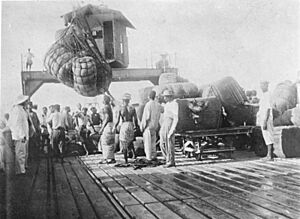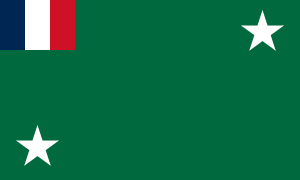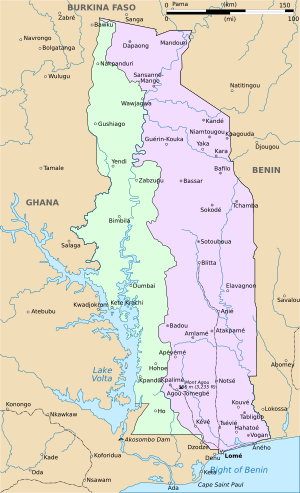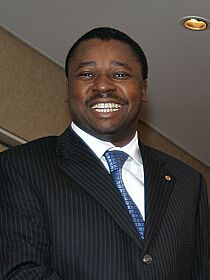History of Togo facts for kids
The history of Togo begins with archaeological discoveries showing that ancient local tribes knew how to make pottery and work with tin. Between the 11th and 16th centuries, groups like the Ewé, the Mina, and the Gun moved into the area. Many of them settled near the coast.
In the late 1400s, Portuguese explorers arrived, followed by other European countries. For a long time, until the 1800s, the coastal area was a big centre for the slave trade. This led to Togo and its neighbours being called "The Slave Coast".
In 1884, Germany claimed a coastal area as a protectorate. This area grew inland and became the German colony of Togoland in 1905. Germany built a railway, the port of Lomé, and other important structures.
During the First World War, Britain and France took over Togoland. In 1922, the League of Nations gave Britain permission to govern the western part of Togo and France to govern the eastern part. After World War II, these areas became UN Trust Territories. In 1957, the people in British Togoland voted to join the Gold Coast, which became the independent nation of Ghana.
French Togoland became the Togolese Republic in 1960. Its first constitution in 1961 created the National Assembly of Togo as the main law-making body. That same year, the first president, Sylvanus Olympio, closed down opposition parties and arrested their leaders. When he was killed in a military takeover (a coup) in 1963, the army gave power to a temporary government led by Nicolas Grunitzky.
In 1967, military leader Gnassingbé Eyadéma took power from Grunitzky without violence. He became president and started a one-party system in 1969. Eyadéma stayed in power for 38 years. When he died in 2005, the military put his son, Faure Gnassingbé, in charge. Gnassingbé then held elections and won, but the opposition said there was cheating. Because of political violence, about 40,000 Togolese people fled to nearby countries. Gnassingbé was re-elected two more times. In late 2017, protests against the government were stopped by security forces.
Contents
Togo's Early History
Not much is known about Togo's history before the late 1400s, when Portuguese explorers arrived. However, there are signs that the Ewe people settled there many centuries earlier. Different tribes moved into the country from all directions. The Ewe came from Benin, and the Mina and Guin came from Ghana. These three groups settled along the coast.
Before the colonial period, the different ethnic groups in Togo didn't have much contact with each other. Except for two small kingdoms in the north, the area was made up of groups of villages. These villages faced military pressure from two powerful West African empires: the Ashanti from Ghana and the Dahomey from Benin.
The first Europeans to see Togo were João de Santarém and Pêro Escobar. These Portuguese explorers sailed along its coast between 1471 and 1473. The Portuguese built forts in nearby Ghana and Benin. Even though Togo's coast didn't have natural harbours, the Portuguese did trade at a small fort at Porto Seguro. For the next 200 years, this coastal area was a major trading centre for Europeans looking for slaves. This is why Togo and the surrounding region became known as "The Slave Coast".
Colonial Rule in Togo
German Togoland
The German Empire created the protectorate of Togoland in 1884. This happened during a time called the "Scramble for Africa", when European powers divided up Africa. Gustav Nachtigal, Germany's official for West Africa, helped make Togoland part of the German colonial empire. He made a deal with King Mlapa III to control the coast, especially the cities of Lomé, Sebe, and Aného. France, which controlled neighbouring Benin at the time, agreed to German rule in the region on December 24, 1885.
The colony was set up in what was then part of the Slave Coast. German control slowly spread inland. Togoland became known as Germany's "model possession". This was because it was the only German colony that could support itself. It also had a good network of railways and roads. Germany opened Togo's first railway line between Lomé and Aného in 1905.
When the First World War started in 1914, the colony was drawn into the conflict. British and French forces quickly invaded and took over Togoland during the Togoland campaign. The area was then placed under military rule. In 1916, the territory was divided into separate British and French zones. This division became official in 1922 with the creation of British Togoland and French Togoland.
League of Nations Mandates
On August 8, 1914, French and British forces invaded Togoland. The German forces there surrendered on August 26. In 1916, Togoland was divided into French and British zones. After the war, Togoland officially became a League of Nations mandate. It was divided for administrative purposes between France and the United Kingdom. After World War I, the newly formed Czechoslovakia was also interested in this colony, but this idea didn't work out. Lomé was first given to the British zone but was transferred to France on October 1, 1920, after discussions.
After World War II, the mandate became a UN trust territory. It was managed by the United Kingdom and France. During these periods, western Togo was managed as part of the British Gold Coast. In December 1956, the people of British Togoland voted to join the Gold Coast. This area became part of the new independent nation of Ghana.
In the 1946 elections for the Representative Assembly, there were two main parties. These were the Committee of Togolese Unity (CUT) and the Togolese Party of Progress (PTP). The CUT won by a lot, and its leader, Sylvanus Olympio, became the Council leader. However, the CUT lost in the 1951 and 1952 elections. They then refused to take part in more French-supervised elections. They claimed that the PTP was getting help from France.
By law in 1955, French Togoland became an independent republic within the French union. But it still kept its UN trusteeship status. After elections on June 12, 1955, which the CUT boycotted, the area gained much power over its internal affairs. It had an elected executive body led by a Prime Minister who answered to the legislature. These changes were put into a constitution approved in a 1956 vote. On September 10, 1956, Nicolas Grunitzky became Prime Minister of the Republic of Togo.
On April 27, 1958, a UN-supervised parliamentary election was held. This was the first election in Togo where everyone could vote. The pro-independence CUT and its leader, Sylvanus Olympio, won. Olympio became Prime Minister. On October 13, 1958, the French government announced that Togo would become fully independent. On November 14, 1958, the United Nations General Assembly noted France's declaration that Togo would gain independence in 1960. This marked the end of the trusteeship period.
On April 27, 1960, Togo smoothly ended its ties with France and its UN trusteeship status. It became fully independent under a temporary constitution, with Olympio as president.
Independence and Political Changes
Quick facts for kids
First Republic of Togo
|
|||||||||
|---|---|---|---|---|---|---|---|---|---|
| 1960–1967 | |||||||||
|
|
|||||||||
|
Anthem: Salut à toi, pays de nos aïeux
(English: "Land of our ancestors") |
|||||||||
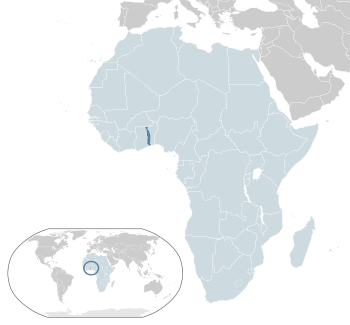 |
|||||||||
| Capital | Lomé | ||||||||
| Government | Presidential republic under a one-party state (1962-1963); under a provisional military junta (1963) | ||||||||
| President | |||||||||
|
• 1960-1963
|
Sylvanus Olympio | ||||||||
|
• 1963
|
Emmanuel Bodjollé (provisional) | ||||||||
|
• 1963-1967
|
Nicolas Grunitzky | ||||||||
| Prime minister | |||||||||
|
• 1960-1961
|
Sylvanus Olympio | ||||||||
| Vice President | |||||||||
|
• 1963-1966
|
Antoine Méatchi | ||||||||
| Legislature | National Assembly | ||||||||
| Historical era | Decolonisation of Africa, Cold War | ||||||||
|
• Independence from France
|
27 April 1960 | ||||||||
|
• Established one-party state
|
January 1962 | ||||||||
|
• 1963 Togolese coup d'état
|
13 January 1963 | ||||||||
|
• 1963 Togolese general election and 1963 Togolese constitutional referendum
|
5 May 1963 | ||||||||
|
• 1967 Togolese coup d'état
|
13 January 1967 | ||||||||
| Currency | West African CFA franc (XOF) | ||||||||
| ISO 3166 code | TG | ||||||||
|
|||||||||
A new constitution was approved in 1961. It created an executive president, elected for 7 years by popular vote, and a less powerful National Assembly. The president could appoint ministers and dissolve the assembly, holding most of the power. In the elections that year, Olympio's party won all the votes and all 51 National Assembly seats. He became Togo's first elected president.
During this time, there were four main political parties in Togo. These were the leftist Juvento, the Democratic Union of the Togolese People (UDPT), the PTP (founded by Grunitzky), and the Party of Togolese Unity, President Olympio's party. Rivalries between these parties had started in the 1940s. They became very strong when Olympio closed down opposition parties in January 1962. He claimed they were plotting against his government. Many opposition members were jailed or fled to avoid arrest.
On January 13, 1963, Olympio was overthrown and killed in a military coup. This was led by army officers who were unhappy with their conditions after leaving the French army. Grunitzky returned from exile two days later to lead a temporary government as prime minister. On May 5, 1963, the Togolese people approved a new constitution. It brought back a multi-party system. They also voted in a general election to choose representatives from all political parties for the National Assembly. Grunitzky was elected president and Antoine Meatchi became vice president. Nine days later, President Grunitzky formed a government that included all parties.
Over the next few years, Grunitzky's government became less secure. On November 21, 1966, an attempt to overthrow Grunitzky failed. This attempt was mainly led by his political opponents. Grunitzky then tried to rely less on the army. But on January 13, 1967, a coup led by Lt. Col. Étienne Eyadéma (later Gen. Gnassingbé Eyadéma) and Kléber Dadjo removed President Grunitzky without violence. After the coup, political parties were banned, and all constitutional processes were stopped. Dadjo became the head of the "committee of national reconciliation". This committee ruled the country until April 14, when Eyadéma became president. In late 1969, a single national political party, the Rally of the Togolese People (RPT), was created. President Eyadéma was elected party president on November 29, 1969. In 1972, a vote confirmed his role as the country's president. Eyadéma was the only candidate.
Eyadéma's Long Rule
|
Togolese Republic
|
|
|---|---|
| 1967–2005 | |
|
|
|
|
Anthem: "L'unité nationale"
|
|
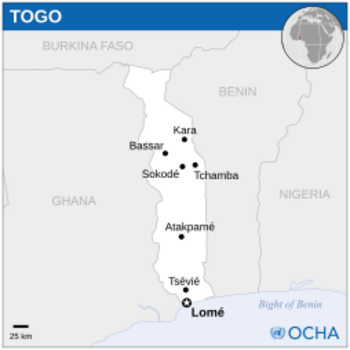 |
|
| Capital | Lomé |
| Government | Military dictatorship (1967–1979) One-party state (1979–1992) Dominant-party republic (1992–2005) |
| President | |
|
• 1967–2005
|
Gnassingbé Eyadéma |
| Prime Minister | |
|
• 1991-1994
|
Joseph Kokou Koffigoh |
|
• 1994-1996
|
Edem Kodjo |
|
• 1996-1999
|
Kwassi Klutse |
|
• 1999-2000
|
Eugene Koffi Adoboli |
|
• 2000-2002
|
Agbéyomé Kodjo |
| Legislature | National Assembly |
| History | |
|
• 1967 coup d'état
|
13 January 1967 |
|
• Eyadéma became president
|
14 April 1967 |
|
• 1979 general election
|
30 December 1979 |
|
• 1979 constitutional referendum
|
30 December 1979 |
|
• Constitutional change
|
27 September 1992 |
| 5 February 2005 | |
| Currency | West African CFA franc |
| ISO 3166 code | TG |
| Today part of | Togo |
The Third Republic
In late 1979, Eyadéma announced a "third republic". This meant a move towards more civilian rule with a government made of both civilians and military members. He won 99.97% of the votes in presidential elections held in late 1979 and early 1980, where he ran unopposed. A new constitution also created a national assembly, mainly to give advice. Eyadéma was re-elected for a third 7-year term in December 1986, winning 99.5% of the vote in an election where he had no opponents. On September 23, 1986, a group of about 70 armed Togolese who were against the government crossed into Lomé from Ghana. They tried to overthrow Eyadéma's government but failed.
Growing Opposition
In 1989 and 1990, Togo, like many other countries, was affected by the democratic changes happening in Eastern Europe. On October 5, 1990, the trial of students who handed out anti-government papers caused riots in Lomé. Anti-government protests and violent clashes with security forces continued for months. In April 1991, the government started talking with new opposition groups. They agreed to a general pardon that allowed political opponents who had left Togo to return. After a general strike and more protests, the government and opposition signed an agreement to hold a "national forum" on June 12, 1991.
The national forum, mostly made up of people against President Eyadéma, opened in July 1991. It immediately declared itself a powerful "National Conference". Even though the government tried to stop it, the conference wrote a temporary constitution. This constitution called for a 1-year temporary government to organize free elections for a new government. The conference chose Joseph Kokou Koffigoh, a lawyer and human rights leader, as the temporary prime minister. President Eyadéma remained the head of state during this time, but with limited powers.
A power struggle between the president and his opponents followed over the next three years. During this time, President Eyadéma slowly gained more control. This period was marked by frequent political problems and occasional violence. After the temporary legislature voted to dissolve the President's political party (the RPT) in November 1991, the army attacked the prime minister's office on December 3 and captured the prime minister. Koffigoh then formed a second temporary government in January 1992. This new government included many ministers from the President's party. Opposition leader Gilchrist Olympio, son of the late president Sylvanus Olympio, was attacked and badly wounded, seemingly by soldiers, on May 5, 1992.
In July and August 1992, a group of representatives from the president's side and the opposition talked and agreed on a new political plan. On September 27, the public strongly approved a new, democratic constitution. This officially started Togo's fourth republic.
Talking with the Opposition
Under strong pressure from inside and outside the country, and facing a general strike, the president's group started talks with the opposition in early 1993. Four rounds of talks led to the July 11 Ouagadougou agreement. This agreement set conditions for upcoming presidential and legislative elections and ended the general strike on August 3, 1993. The presidential elections were set for August 25. However, quick and poor preparations, worries about cheating, and the opposition's lack of good campaign organization led the main opposition candidates to drop out. They called for people to boycott the election. President Eyadéma won the elections with 96.42% of the vote against minor opposition. About 36% of voters participated; the rest boycotted.
Armed groups based in Ghana launched a new attack on military sites in Lomé in January 1994. President Eyadéma was not hurt. The attack and the army's response led to hundreds of deaths, mostly civilians. The government went ahead with legislative elections on February 6 and February 20, 1994. International observers said the elections were generally fair. The allied opposition parties, UTD and CAR, together won a small majority in the National Assembly.
Edem Kodjo Becomes Prime Minister
On April 22, President Eyadéma named Edem Kodjo as prime minister. Kodjo was the head of the smaller opposition party, the UTD. This was instead of Yawovi Agboyibo, whose CAR party had many more seats. Kodjo's decision to accept the prime minister position caused the CAR to break its alliance with the opposition. They refused to join Kodjo's government.
Kodjo then had to form a government with Eyadéma's RPT party. Kodjo's government focused on improving the economy, building democratic systems, and bringing back Togolese refugees. In early 1995, the government made slow progress. This was helped by the CAR's decision in August 1995 to end its 9-month boycott of the National Assembly. However, Kodjo had to change his government in late 1995, giving more power to Eyadéma's RPT party. He resigned in August 1996. Since then, Eyadéma regained strong control over most parts of the government.
In the June 1998 presidential election, the government made it hard for citizens to vote properly. The Interior Ministry announced Eyadéma as the winner with 52% of the vote. However, there were serious problems in how the government ran the election. These problems strongly favoured the current president and seemed to have changed the outcome. Even though the government didn't openly stop political opponents, the President used the military and his government allies to scare and bother citizens and opposition groups. The government remained very centralized. President Eyadéma's national government appointed officials and controlled the money for all local government bodies. He also influenced the choice of traditional chiefs.
National Assembly Elections
The second multi-party legislative elections during Eyadéma's 33-year rule were held on March 21, 1999. However, the opposition parties boycotted the election. As a result, the ruling party won 79 of the 81 seats in the National Assembly. The other two seats went to candidates from less known independent parties. Problems with procedures and significant cheating, especially about voter turnout, made the elections unfair.
After the legislative election, the government said it would continue to talk with the opposition. In June 1999, the RPT and opposition parties met in Paris. They were helped by representatives from France, Germany, the European Union, and La Francophonie (French-speaking countries). They agreed on safety measures for formal talks in Lomé. In July 1999, the government and opposition started discussions. On July 29, 1999, all sides signed an agreement called the "Lomé Framework Agreement". This included a promise from President Eyadéma that he would follow the constitution and not seek another term as president after his current one ended in 2003.
The agreement also called for a legal status for opposition leaders and former heads of state. This included their protection from being charged for actions taken while in office. In addition, the agreement talked about the rights and duties of political parties and the media. It also covered the safe return of refugees and the safety of all citizens. The agreement also had a rule for paying back victims of political violence. The President also agreed to dissolve the National Assembly in March and hold new legislative elections. These elections would be overseen by an independent national election commission. They would also use a single-ballot method to prevent some of the problems from past elections. However, the March 2000 date passed without the president acting. New legislative elections were finally moved to October 2001. Because of money problems and disagreements between the government and opposition, the elections were delayed again, this time until March 2002.
In May 2002, the government got rid of the independent election commission. They blamed the opposition for its inability to work. Instead, the government appointed seven judges to oversee election preparations. As expected, the opposition announced they would boycott the elections. Held in October, the government party won more than two-thirds of the seats in the National Assembly because the opposition boycotted. In December 2002, Eyadéma's government used this parliament to change Togo's constitution. This allowed President Eyadéma to run for an "unlimited" number of terms. Another change said that candidates must live in the country for at least 12 months before an election. This rule stopped the popular candidate, Gilchrist Olympio, from participating. He had been living outside the country since 1992. The presidential election was held on June 1. President Eyadéma was re-elected with 57% of the votes. There were many claims of widespread vote rigging.
Eyadéma's Death and Faure Gnassingbé's Rise
President Eyadéma died on February 5, 2005. He was on an airplane going to France for treatment for a heart attack. His son, Faure Gnassingbé, who was the country's minister of public works, mines, and telecommunications, was named President by Togo's military after his father's death was announced. However, under international pressure from the African Union and the United Nations, who both called the transfer of power a coup, Gnassingbé was forced to step down on February 25, 2005. This happened shortly after he agreed to run for elections in April. Deputy Speaker Bonfoh Abbass was appointed temporary president until the winner of the April 24 election was sworn in.
According to official results, the winner of the election was Gnassingbé, who received 60% of the vote. However, opposition leader Emmanuel Bob-Akitani disagreed with the election results and said he was the winner with 70% of the vote. After the results were announced, tensions grew, and 100 people were killed. On May 3, 2005, Gnassingbé was sworn in. He promised to focus on "the promotion of development, the common good, peace and national unity".
Faure Gnassingbé in Power (2005-Present)
In August 2006, President Gnassingbé and members of the opposition signed the Global Political Agreement (GPA). This agreement ended the political crisis that started with Gnassingbé Eyadéma's death in February 2005 and the flawed elections that followed. The GPA created a temporary unity government. Its main goal was to prepare for important legislative elections, which were first planned for June 24, 2007.
Yawovi Agboyibo, a leader of the CAR opposition party and a human rights lawyer, was named Prime Minister of the temporary government in September 2006. Leopold Gnininvi, president of the CDPA party, became minister of state for mines and energy. The third opposition party, UFC, led by Gilchrist Olympio, chose not to join the government. However, they agreed to be part of the national electoral commission and the National Dialogue follow-up committee.
Parliamentary elections took place on October 14, 2007. Olympio, who returned from exile to campaign, took part for the first time in 17 years. The ruling party, Rally of the Togolese People (RPT), won most of the seats in parliament. International observers said the election was "largely" free and fair. Despite these statements, the secretary-general of the opposition party Union of Forces for Change (UFC) first said his party would not accept the results.
Mr. Olympio stated that the election results did not truly show what voters wanted. He pointed out that the UFC received almost as many votes as the RPT. However, because of how the election system was set up, the UFC won far fewer seats.
In April 2015, President Faure Gnassingbé was re-elected for a third term. In late 2017, tens of thousands of people gathered in a series of large protests. They demanded that President Faure Gnassingbé resign immediately. In February 2020, Faure Gnassingbé was again re-elected for his fourth presidential term. The opposition made many accusations of cheating and problems. The Gnassingbé family has ruled Togo since 1967, making it Africa’s longest-lasting ruling family.
In June 2022, Togo joined the Commonwealth of Nations as its 56th member.
See also
 In Spanish: Historia de Togo para niños
In Spanish: Historia de Togo para niños
- History of Africa
- History of West Africa
- List of heads of government of Togo
- List of heads of state of Togo
- Politics of Togo
- Lomé history and timeline


